Kiev
![]()
The title of this article is ambiguous. For other meanings, see Kiev (disambiguation).
Kiev (Ukrainian Київ Kyiv [ˈkɪjɪu̯]; Russian Киев Kiev [ˈkʲi(ɪ̯)ɪf]) is the capital and largest city of Ukraine, as well as the administrative seat of Kiev Oblast and Kiev-Svyatoshyn Rajon. It is located on the Dnieper River, navigable up to this point for smaller seagoing vessels, and has a population of nearly 3 million in an area of 847.66 km². The agglomeration comprises more than four million inhabitants.
Kiev is considered an important educational and industrial centre and is also the country's most important transport hub. Due to its historical significance as the centre of Kievan Rus, the city has often been called the Mother of All Russian Cities, since the same name was used in the Nestor Chronicles. Because of its many churches and monasteries and its importance for Orthodox Christianity, Kiev has also been called the Jerusalem of the East since the Middle Ages. After the end of World War II, Kiev received the distinction of a Hero City. The asteroid (2171) Kiev, discovered on August 28, 1973 by T. M. Smirnova at the Crimean Observatory, was named after the city, as was a peninsula in Antarctica in 2010.

Logo of the city of Kiev
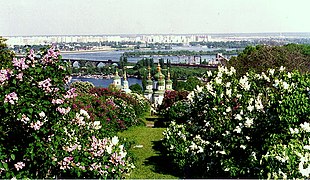
Kiev, seen from the Vydubychi Monastery
Geography
Topography
The city lies on both banks of the Dnieper River, which flows south towards the Black Sea. The right, western bank of the river with the historic city center is characterized by numerous, originally forested, small hills of the Dnieper highlands. A constant up and down as well as chestnut trees are typical for the city centre of Kiev. The hills here slope steeply down to the river. Further north - in the district of Podil - there is a flat and wide, built-up bank.
The left, eastern bank of the river was only developed in the 20th century. In contrast to the opposite side, it is flat and characterised by forest steppe. There are also numerous lakes here. Some small tributaries, such as the Lybid, flow into the Dnepr within the city area. This river branches into numerous watercourses in the city area. The Truchaniw Island and other larger islands, which have hardly been built on, serve as recreational areas.
Climate
Kiev is located in the northern part of Ukraine. Summers are warm with average temperatures from 19.3 to 25.3 °C in June, July and August. The coldest months are December, January and February with average temperatures of -4.6 to -1.1 °C. A record high temperature of 39.4 °C was recorded on July 31, 1936. The lowest recorded temperature was -32.2 °C on February 9, 1929. Kiev was usually covered with snow from mid-November to late March, although this has been declining in recent years.
| Kiev | ||||||||||||||||||||||||||||||||||||||||||||||||
| Climate diagram | ||||||||||||||||||||||||||||||||||||||||||||||||
| ||||||||||||||||||||||||||||||||||||||||||||||||
| Monthly average temperatures and precipitation for Kiev
Source: Ukrainian Hydrometeorological Center, data: 1961-1990; wetterkontor.de | ||||||||||||||||||||||||||||||||||||||||||||||||||||||||||||||||||||||||||||||||||||||||||||||||||||||||||||||||||||||||||||||||||||||||||||||||||||||||||||||||||||||||||||||||||||||||||||||||||||||||||||||||||||||||||||||||||||||||||||||||||||||||||||

The cave monastery and the Mother-Home statue situated on the hills of the western bank of the Dnieper, behind it the Dnieper and its shallow eastern shore.
History
The oldest settlement finds in the present-day city area date back to the Magdalenian culture and are located at the Kiev-Kyrill habitation site in the Podil district.
Foundation
According to the Nestor Chronicle, Kiev was founded by the three brothers Kyj, Shchek and Doriv and their sister Lybid from the tribe of the Poljans, who built villages on three hills. They built another fortress, which they named after the eldest brother ("Kiev" = 'City of Kyj', Ukrainian: Kyjiw). This is said to have happened at the beginning of the 6th century at the latest, since the name of the East Slavic prince Kyj was mentioned in Byzantine chronicles at that time.
According to some Western, but also some Ukrainian historians (Kevin Alan Brook, Omeljan Pritsak), Kiev is said to have been founded instead around 840 by Muslim mercenaries in the Khazarian army as a Khazarian garrison in the Poljanenland, the name of the city is said to be of East-Iranian origin like these mercenaries. It was not until around 930 that Slavs and Varangians are said to have conquered the city. However, this theory contradicts chronicles of Varangian rulers from this period.
Medieval heyday
The city had a strategic location on the trade route from the Baltic to the Black Sea, the route from the Varangians to the Greeks. In the middle of the 9th century, the Varangian princes Askold and Dir ruled in it before they were killed by Rurik's commander Oleg of Novgorod in 882. The latter unified the entire domain of the Varangians (Rus) along the trade route and made Kiev the princely residence of Rus. In 988, the Grand Prince Vladimir I initiated the conversion of the hitherto pagan Rus to Byzantine-style Orthodox Christianity. This act was marked by a mass baptism of the Kievan population in the Dnieper River and the overthrow of the old idols in the river. Under Vladimir's son Yaroslav the Wise, Kiev was greatly expanded. Besides numerous new churches and monasteries, the first East Slavonic library was founded. The active marriage policy and the expansion of the city made it known throughout Europe. Thus, Kiev reached the peak of its development in the 11th and 12th centuries and became one of the largest cities in Europe.
Downfall
After the death of Yaroslav, succession struggles began, which had a negative impact on the city and led to repeated conquests and destruction. Thus, in 1169 Kiev was conquered by Prince Andrei Bogolyubsky of Vladimir-Suzdal. Instead of settling there, he took the grand ducal title, which had until then been attached to Kiev, north to his residence near Vladimir. Thus the disintegration of the Kievan Empire continued. The fact that Kiev was no longer the seat of the Grand Prince did not mean the downfall of the city, since the metropolitans of the Russian Orthodox Church still resided in Kiev until the end of the 13th century.
In 1240, in the course of the Mongol invasion of Rus, Kiev was conquered by Batu Khan's troops after almost ten weeks of siege. Almost all the inhabitants were killed and almost all the buildings were burned down. It was reported that of the large and densely populated city, only 200 houses were left standing. After another destruction of the city, the Orthodox metropolitan left Kiev in 1299 and moved to Vladimir. In 1320/1365 Kiev came to Lithuania as a result of the Battle of the Irpen and the Battle of the Blue Water. At first, the Kiev principality, which dated back to the time of Kievan Rus, enjoyed a certain autonomy within Lithuania. However, the rulers of Lithuania feared separation and dissolved the principality. In 1482 Kiev was devastated by the Crimean Khan Meñli I Giray. The city became a Polish-Lithuanian provincial capital (Kiev Voivodeship) in 1569. After the 1596 Church Union of Brest, Kiev became the scene of a confessional struggle between the Catholics and Uniates, on the one hand, and the Orthodox, on the other, who rejected an imposed subordination to the pope. In 1632 the Kiev Mohyla College was founded, the first university in the Eastern Slavic region.
Russian Empire
After the Khmelnytsky Uprising, which began in 1648, Kiev became the capital of the Zaporozhian Cossack Hetmanate. These subordinated themselves in 1654 in the agreement of Perejaslaw to the Moscow tsar. Under the rule of the Cossack hetman Ivan Masepa many important buildings were renovated and schools were founded. The Kiev Cave Monastery, St. Sophia's Cathedral and St. Michael's Monastery received their present appearance in the style of Ukrainian Baroque. Under Empress Elizabeth the Baroque St. Andrew's Church and St. Mary's Palace were built. The urban development suffered a setback during the great fire in the Kiev district of Podil in 1811.
Emperor Nicholas I in particular, who affectionately called Kiev the Jerusalem of Russian Earth, did much to develop Kiev into an important commercial, transport and industrial centre of the Russian Empire. Among other things, he had St. Vladimir University, now the Taras Shevchenko National University of Kiev, founded and initiated the construction of the massive Nicholas Chain Bridge over the Dnieper River. In 1888 the city celebrated with great pomp the 900th anniversary of the Christianization of Rus. To this anniversary was dedicated the construction of the Vladimir Cathedral in the Byzantine style.
In 1892, Kiev became the first city in the Russian Empire to receive an electric tram. By 1900, at the end of Mayor Stepan Solskyj's term, the city had about 250,000 inhabitants, and the population continued to grow massively over the next few years. In 1911, Russian Prime Minister Pyotr Stolypin was shot dead in Kiev by an anarchist. After the Russian Revolution and during the German occupation at the end of World War I, the short-lived Ukrainian nation-states Ukrainian People's Republic and Ukrainian State emerged here.
Soviet era
From 1920 Kiev was Soviet and initially only the administrative seat of the Kiev Okrug and Kiev Oblast. On 19 January 1934, the city became the capital of the Ukrainian Soviet Socialist Republic (SSR) in place of Kharkov, and on 24 June 1934 the government moved here. During the 1930s, many historic buildings in Kiev were destroyed by the Soviet authorities. In Bykiwnja, a forest area in the east of the city, about 130,000 people were murdered during Stalinism.
Before the German invasion of the Soviet Union, the city had 350,000 Jews, most of whom managed to escape in time before the Wehrmacht invasion, so that by the time of the invasion in September 1941, only 30% of the Jews were still living in the city (about 100,000 Jews). During the German occupation in the German-Soviet War, from September 19, 1941 to November 6, 1943, 120,000 to 160,000 Soviet prisoners of war and civilians (mostly Jews) were murdered in Kiev by the occupiers. More than 33,000 Jews alone fell victim to the Babi Yar massacre near Kiev on September 29 and 30, 1941. In 1942, the Syrez concentration camp was established on the northern edge of the city.
Shortly after the Battle of Kiev, the city suffered major damage from a devastating conflagration caused by remotely detonated Soviet explosives on September 24, 1941, which could only be extinguished on September 29 by blasting firebreaks with the help of German and local firefighters. In a second battle for Kiev, the city was liberated by the Red Army on November 6, 1943, after 778 days of German occupation. POW camp 62 for German POWs of World War II existed in the city (until 1954), along with POW hospital 3201. There were several POW cemeteries, the largest north of the city with about 20,000 dead.
In the post-war period, the city was rapidly rebuilt and continued its rapid population growth. In particular, the central street Khreshchatyk and today's Majdan Nesaleshnosti (then Kalinin Square, later October Revolution Square) were monumentally expanded and rebuilt. The Kiev metro was built on the Moscow model. To commemorate the victory in the Great Patriotic War on the high right side of the Dnieper was built the huge statue of Mother Homeland.
In 1982, the celebrations of the 1500th anniversary of Kiev took place. In 1986 the city was badly hit by the Chernobyl accident.
After the city area was extended by 110.7 hectares on April 4, 1978 and by 624.3 hectares on March 5, 1982, the last extension of the city area took place on August 26, 1988 with the incorporation of 3440 hectares of the Kiev hinterland.
Kiev as of Ukrainian independence in 1991
Kiev has been the capital of independent Ukraine since 1991. As a result, many buildings destroyed during the Stalinist period were rebuilt, such as St. Michael's Monastery and the Church of the Nativity of Christ in the Podil district. From November 2004, the city centre became the scene of mass protests against the rigging of the 2004 presidential election, which eventually led to the Orange Revolution. From December 2013 to the end of February 2014, the city was the scene of the "Euromaidan", a protest movement against the Ukrainian government, which led to its overthrow. After Russia annexed Crimea, it abandoned its opposition to an OSCE observer mission to Ukraine and observers were deployed to the city on 21 March 2014. On 9 October 2019, 19 municipalities established the Kyiv Agglomeration (Київська агломерація) to accelerate the socio-economic development and infrastructure development of the agglomeration and increase the investment attractiveness of the Kyiv metropolitan area with more than 4 million inhabitants.
After the first cases of corona virus infection appeared in Kyiv at the beginning of the COVID-19 pandemic in Ukraine on March 16, 2020, the Kyiv Metro was closed by order of the Ukrainian President from March 18 to May 25, 2020. By February 7, 2021, 130,236 people in Kyiv had contracted COVID-19, by which time 79,510 people had recovered from the disease and 2442 had died in connection with it.
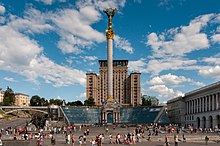
Majdan Nesaleshnosti
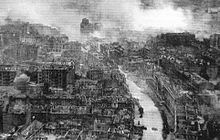
Kiev during the Second World War
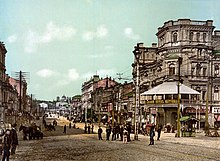
Khreschchatyk 1899

Monument to the Cossackhetman Bohdan Khmelnytskyj, the leader of the great uprising against the Polish rule
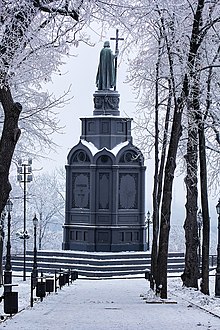
Monument to Vladimir the Saint
Search within the encyclopedia